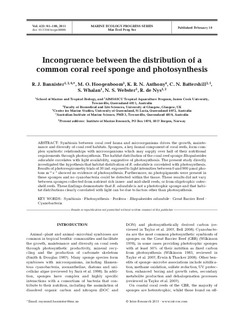| dc.contributor.author | Bannister, Raymond | |
| dc.contributor.author | Hoogenboom, Mia O. | |
| dc.contributor.author | Anthony, Kenneth R.N. | |
| dc.contributor.author | Battershill, Christopher N. | |
| dc.contributor.author | Whalan, Steve | |
| dc.contributor.author | Webster, Nicole S. | |
| dc.contributor.author | de Nys, Rocky | |
| dc.date.accessioned | 2012-11-13T18:20:00Z | |
| dc.date.issued | 2011-02-10 | |
| dc.identifier.issn | 0171-8630 | |
| dc.identifier.issn | 1616-1599 | |
| dc.identifier.uri | http://hdl.handle.net/11250/109118 | |
| dc.description.abstract | Symbiosis between coral reef fauna and microorganisms drives the growth, maintenance
and diversity of coral reef habitats. Sponges, a key faunal component of coral reefs, form complex
symbiotic relationships with microorganisms which may supply over half of their nutritional
requirements through photosynthesis. The habitat distribution of the coral reef sponge Rhopaloeides
odorabile correlates with light availability, suggestive of photosynthesis. The present study directly
investigated the hypothesis that habitat distribution of R. odorabile is correlated with photosynthesis.
Results of photorespirometry trials of 30 ind. exposed to light intensities between 0 and 900 μmol photons
m–2 s–1 showed no evidence of photosynthesis. Furthermore, no photopigments were present in
these sponges and no cyanobacteria could be detected within the tissue. These results did not vary
between sponges collected from nutrient rich inner- and mid-shelf reefs, or from oligotrophic outershelf
reefs. These findings demonstrate that R. odorabile is not a phototrophic sponge and that habitat
distributions clearly correlated with light can be due to factors other than photosynthesis. | no_NO |
| dc.language.iso | eng | no_NO |
| dc.publisher | Inter-Research | no_NO |
| dc.subject | coral reef | no_NO |
| dc.subject | korallrev | no_NO |
| dc.subject | distribution | no_NO |
| dc.subject | utbredelse | no_NO |
| dc.title | Incongruence between the distribution of a common coral reef sponge and photosynthesis | no_NO |
| dc.type | Journal article | no_NO |
| dc.type | Peer reviewed | no_NO |
| dc.subject.nsi | VDP::Agriculture and fishery disciplines: 900::Fisheries science: 920::Resource biology: 921 | no_NO |
| dc.subject.nsi | VDP::Mathematics and natural science: 400::Zoology and botany: 480::Marine biology: 497 | no_NO |
| dc.description.embargo | 2016-02-10 | |
| dc.source.pagenumber | 95-100 | no_NO |
| dc.source.volume | 423 | no_NO |
| dc.source.journal | Marine Ecology Progress Series | no_NO |
| dc.identifier.doi | http://dx.doi.org/10.3354/meps08886 | |
